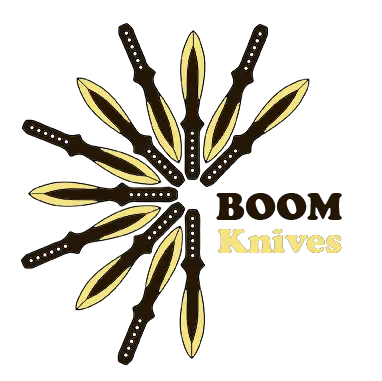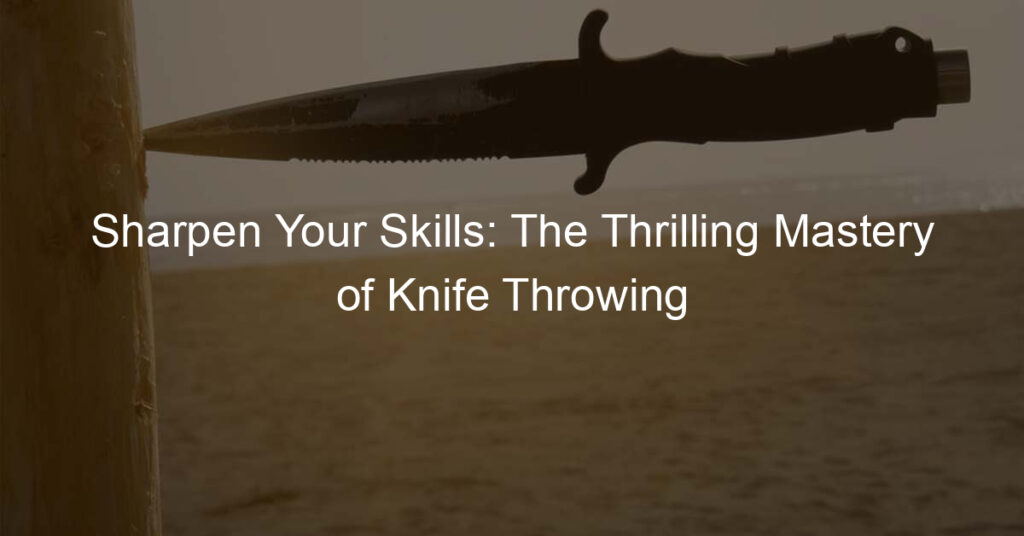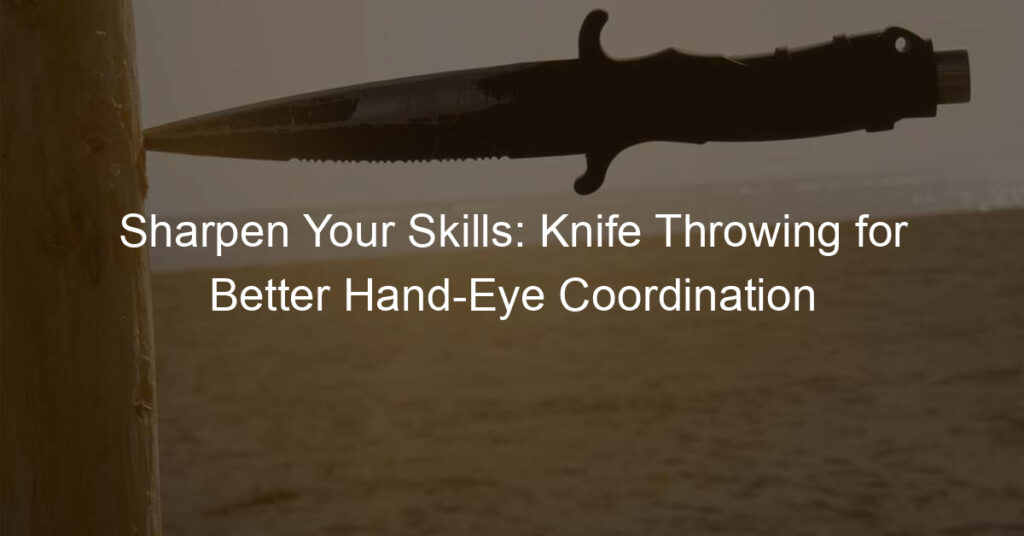Introduction to Knife Throwing
It is an art form that requires precision, focus, and a deep understanding of the tools and techniques involved. In this section, we will delve into the fascinating world of knife throwing.
-
- Understanding the Art of Knife Throwing
A skill that has been practiced for centuries. It is a form of art that requires a deep understanding of the dynamics of the knife and the thrower’s body. The thrower must be able to gauge the distance, the rotation of the knife, and the force required to hit the target accurately. It’s not just about strength; it’s about finesse, timing, and precision. Learn more about the art of knife throwing here.
It dates back to prehistoric times when early humans used thrown knives as hunting tools. Over time, this skill evolved and was adopted by various cultures for different purposes, including warfare, sport, and entertainment. In the modern era, knife throwing has gained popularity as a competitive sport and recreational activity. Read more about the history and evolution of knife throwing here.
-
- The Role of Precision in Knife Throwing
It’s not just about hitting the target; it’s about hitting the exact spot you aimed for. This requires a deep understanding of the knife’s weight, the distance to the target, and the force required to throw the knife accurately. Precision in knife throwing is a skill that can be honed with practice and patience. Discover more about the role of precision in knife throwing here.
Mastering Knife Throwing: The Basics
Choosing the Right Equipment
-
- Types of Throwing Knives
The three main types are the blade-heavy, handle-heavy, and balanced knives. Blade-heavy knives are easier to throw, making them suitable for beginners. Handle-heavy knives require more skill but offer greater control. Balanced knives, as the name suggests, have an equal weight distribution, providing a consistent throw.
-
- Importance of Knife Balance
A well-balanced knife rotates uniformly, increasing the chances of hitting the target accurately. It also helps in maintaining a consistent throwing technique. A poorly balanced knife can lead to inconsistent throws and missed targets.
-
- Choosing the Right Target
Should be made of soft material like wood or foam that can absorb the impact of the knife. It should be large enough to catch missed throws and should be placed at a safe distance to avoid accidents. Safety should be your top priority.
Basic Knife Throwing Techniques
-
- Understanding the Grip
A firm yet relaxed grip ensures that the knife leaves your hand smoothly when you throw it. The most common grip is the hammer grip, where the handle of the knife rests in your palm and your fingers wrap around it, just like holding a hammer. The thumb is positioned along the spine of the knife for added control. The grip should be firm enough to control the knife but not so tight that it affects the throw. Learn more about the grip here.
-
- Mastering the Stance
Stand with your feet shoulder-width apart, with your non-throwing foot slightly forward. Your body should be aligned with the target, and your weight should be evenly distributed on both feet. As you prepare to throw, shift your weight to your back foot, then to your front foot as you release the knife. This movement helps generate power for the throw. Practice this stance until it feels natural and comfortable.
-
- Perfecting the Throw
By extending your throwing arm straight out in front of you, aiming at the target. Your wrist should be locked to ensure a straight throw. As you throw, your arm should move in a smooth, fluid motion, like a whip. Release the knife when your arm is almost fully extended, and follow through with your arm movement. The key to a successful throw is consistency. Practice the same motion over and over until you can consistently hit the target. Find more tips on perfecting the throw here.
Advanced Knife Throwing Techniques
Improving Precision and Accuracy
- Advanced Grip Techniques: The way you hold your knife plays a significant role in the accuracy of your throw. The most common grip for advanced knife throwing is the ‘hammer grip.’ This grip involves holding the knife handle as if you were gripping a hammer, ensuring a firm but not tight hold. This grip allows for a controlled release, improving your throw’s accuracy. You can learn more about it here.
- Enhancing Your Aim: Aiming is a skill that requires practice. One effective method is to visualize a straight line from your eye to the target. Keep your eye on the target, not on the knife. Over time, this practice will help improve your aim and, consequently, your accuracy.
- Increasing Throwing Speed Without Losing Accuracy: Throwing speed is important, but not at the expense of accuracy. To increase your throwing speed without losing accuracy, focus on your body movement. A fluid, swift, and controlled motion can help increase the speed of your throw while maintaining accuracy.
Mastering Multiple Knife Throws
- Throwing multiple knives at once
- Sequential knife throwing
- Mastering the rhythm and timing
Throwing Multiple Knives at Once
Throwing multiple knives at once is a skill that requires a lot of practice and concentration. It’s not just about throwing the knives, but also about controlling their direction and speed. This can be achieved by practicing with different types of knives and adjusting your grip and throwing technique for each one.
Sequential Knife Throwing
This involves throwing a series of knives in quick succession, each one aimed at a different target or part of the target. It’s important to maintain a steady rhythm and to focus on each throw individually, rather than trying to throw all the knives at once.
Mastering the Rhythm and Timing
You need to be able to control the speed and timing of each throw to ensure that each knife hits its target accurately. This requires a lot of practice and a good understanding of the physics of knife throwing. A good way to practice this is to use a metronome or a piece of music with a steady beat to help you establish a rhythm.
Professional Knife Throwing
As you advance in your knife throwing journey, you may find yourself drawn to the competitive side of this unique sport. Let’s delve into the world of professional knife throwing, where precision, skill, and determination are key.
Competitive Knife Throwing
-
- Understanding competition rules
Every competition has a set of rules that participants must follow. These rules may include the type of knives allowed, the distance from the target, and the scoring system. Familiarize yourself with these rules to avoid disqualification. You can find a comprehensive list of rules on the Wikipedia page for Knife Throwing.
-
- Training for competitions
Training is crucial for success in any sport, and knife throwing is no exception. Practice your aim, work on your throwing technique, and build your endurance.
-
- Case study: Top knife throwing champions
Studying the techniques and strategies of top knife throwing champions can provide valuable insights. For instance, consider the case of Adam Celadin, a five-time World Champion in knife throwing. His success can be attributed to his disciplined training regimen, deep understanding of competition rules, and unwavering focus during competitions.
Competitive knife throwing can be a thrilling and rewarding pursuit. With the right understanding, training, and inspiration, you too can aim for the top.
Turning Knife Throwing into a Career
-
- Building a Professional Portfolio
Just like any other profession, a strong portfolio is crucial in knife throwing. This is a collection of your best work, showcasing your skills and achievements. It can include videos of your performances, testimonials from coaches or peers, and records of your participation in competitions. Your portfolio is your personal brand. It should reflect your unique style and abilities.
-
- Finding the Right Opportunities
They could be performance gigs at events, teaching positions in knife throwing schools, or even spots in professional competitions. Keep an eye on job boards, join knife throwing forums, and follow industry leaders on social media. You never know where the next opportunity might come from.
-
- Networking in the Knife Throwing Community
Networking is key in any profession, and knife throwing is no exception. Attend knife throwing events, join online communities, and connect with other professionals in the field. Not only can this lead to job opportunities, but it can also provide valuable insights and advice. The knife throwing community is a tight-knit one, and a good reputation can go a long way.
Turning knife throwing into a career may seem like a daunting task, but with the right approach, it’s entirely possible. Build a strong portfolio, actively seek out opportunities, and network within the community. With dedication and hard work, you can turn your passion into a rewarding career.
Conclusion: The Art and Mastery of Knife Throwing
Knife throwing is a fascinating art that requires precision, focus, and a lot of practice. As we’ve explored throughout this post, mastering this skill involves understanding the basics, learning advanced techniques, and adopting the mindset of a professional. Let’s recap what we’ve learned and discuss the importance of constant practice and some final tips to help you on your journey to mastering knife throwing.
- Recap of knife throwing techniques: We began with the basics, learning the correct grip and stance for knife throwing. We then delved into advanced techniques, such as the no-spin throw and the long-distance throw. The key to successful knife throwing lies in the balance between strength and precision. For more detailed information, revisit the sections on Mastering Knife Throwing: The Basics and Advanced Knife Throwing Techniques.
- Importance of constant practice: As the old saying goes, “practice makes perfect.” This is particularly true in the case of knife throwing. The more you practice, the better your aim and precision will become. According to a Wikipedia article on knife throwing, most professional throwers practice several hours a day. So, set aside regular time for practice and stick to it.
- Final tips for mastering knife throwing: Always use a safe, designated area for your practice and ensure no one is in your throwing path. Keep your knives sharp and well-maintained, and always handle them with care. And most importantly, be patient with yourself. Mastery takes time, but with dedication and persistence, you will see progress.
The art and mastery of knife throwing is a journey of constant learning and practice. It’s an exciting and rewarding skill to develop, offering not just a fun hobby, but also a unique way to improve focus, coordination, and discipline.







